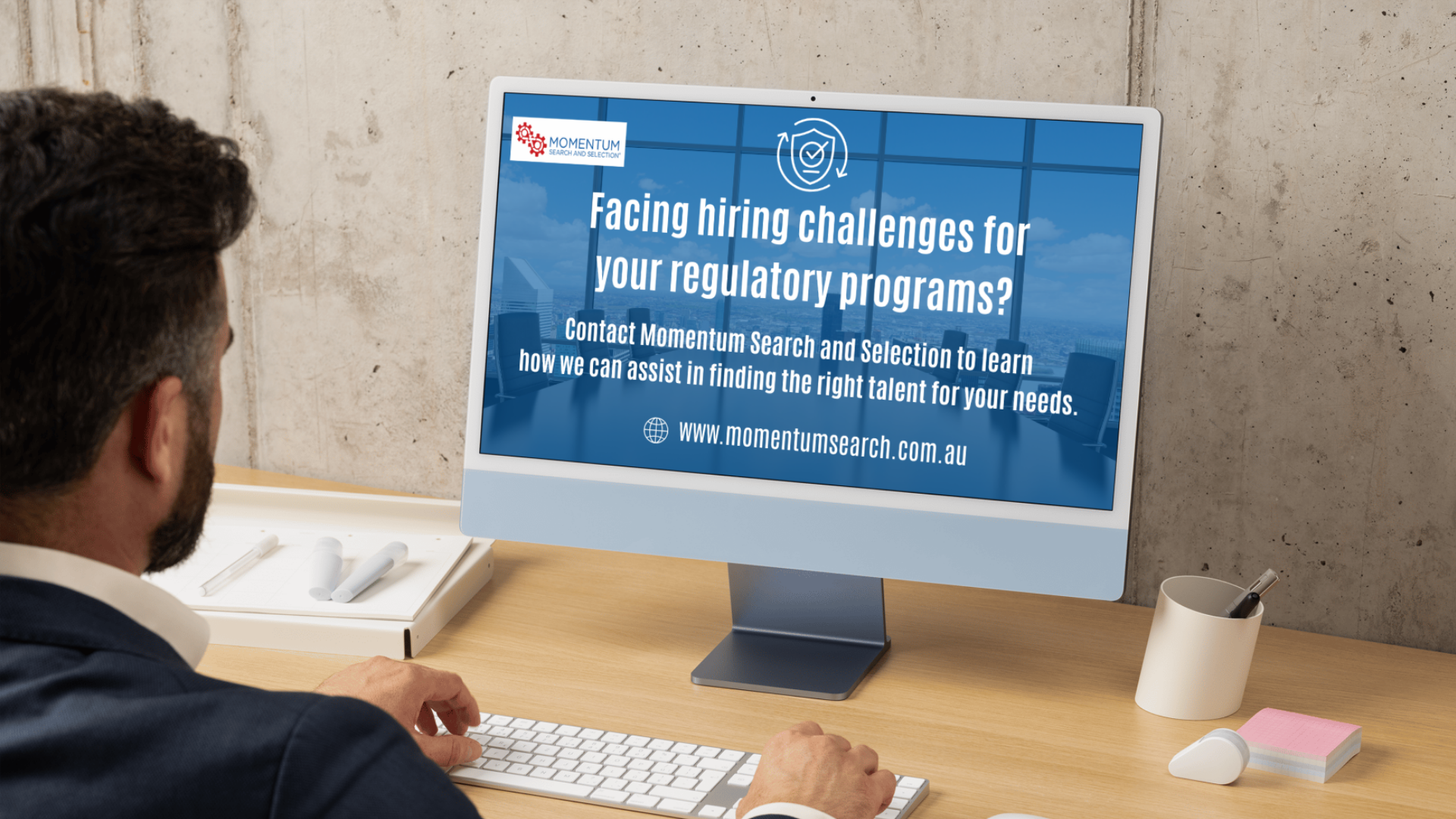Alan Herrity | July 14, 2025

Introduction
Since the 2018 findings of Australia’s Royal Commission into misconduct in the Banking, Superannuation, and Financial Services Industries, regulatory reform has continued to accelerate.
APRA’s mandates, such as CPS 230, CPS 234, AASB 17 and Payday Super — have reshaped how organisations operate. As a result, many organisations have mobilised regulatory programs quickly, often under delivery pressure.
Having supported clients through regulatory transformation since the first wave of post-Royal Commission programs, we’ve seen firsthand how the right hire — made at the right time — can set programs up for success.
Specifically, the need for highly targeted and discreet appointments — at both leadership and program levels with regulatory expertise — has become a strategic priority.
Understanding the Regulatory Hiring Landscape
We’ve seen several reasons why regulatory hiring presents unique challenges:
- High-demand talent is already engaged. Since 2018, individuals with regulatory program experience have remained in steady demand—often continuously engaged across banking, superannuation, and insurance projects. These candidates are not typically applying for roles; they must be identified, referred, or headhunted directly.
- Confidentiality is critical. Many of these roles involve approaching talent from competitors, demanding discretion and professionalism.
- Role clarity evolves. Regulatory programs often begin with high-level roadmaps. In the case of APRA, organisations are expected to proactively define how to meet regulatory milestones. This shifting context demands teams who are adept at managing ambiguity and aligning solutions with regulatory intent.
Hiring delays don’t just slow progress—they can impact program timelines, regulatory milestones, and governance reporting at the board level.
Why a Diagnostic-Led Approach Is Essential
At Momentum Search and Selection, we begin each engagement with a structured diagnostic. It clarifies:
- The regulatory obligations in scope
- The program structure and delivery timelines
- The specific capability and experience required to execute
This diagnostic phase is critical, particularly when briefs are evolving or direction is still emerging.
Many organisations initially turn to large consultancies, but what they often need is something more targeted, a contractor who brings the right crossover. The strongest candidates typically sit in the “Venn diagram“ where practitioner experience meets deep regulatory understanding.
A robust diagnostic doesn’t just define requirements—it provides structure, reduces the risk of mis-hiring, and ensures that each role is designed with intent, even when regulatory mandates are still taking shape.
What a Regulatory Program Team Typically Looks Like
The structure of a high-performing regulatory program team often includes:
- Executive sponsor with board-level ownership and buy-in
- Program Director with proven experience leading regulatory transformation
- Practitioner-level roles such as Project Managers, Business Analysts, Risk Specialists, and Change Managers
- Specialist contractors who bring both delivery capability and domain expertise
“You need the right executives to lead regulatory transformation. Then, appointing the right Program Director is absolutely key.”
Regulatory Program leaders don’t just look for role clarity—they look for executive and board-level buy-in. Without that, even the best-structured teams struggle to gain momentum. Executive and board-level sponsorship is key. We explore this further in
The Key to Executive Search: Aligning Stakeholders from the Outset, where early alignment among senior stakeholders is shown to be a differentiator in search outcomes.
Why Traditional Hiring Models Fall Short
Many organisations attempt to fill regulatory roles through conventional recruitment channels. In our experience, these approaches fall short due to three key assumptions:
- That suitable candidates are available and applying
- That a job ad will reach the right people
- That consultancies can always supply tailored talent for niche regulatory needs
In reality, the best candidates are already delivering value elsewhere. They must be approached directly and discreetly. Partnering with a search firm like Momentum Search and Selection is essential.
The Momentum Search and Selection Approach
Our regulatory hiring methodology is consistent, structured, and outcome-focused. It applies to both permanent and interim roles:
- Structured diagnostic to define the problem
2. Stakeholder alignment and brief development
3. Market mapping and planning
4. Discreet outreach through our network and headhunting
5. Weekly steering meetings for transparency and progress
6. Presentation of a refined, high-quality shortlist
As we’ve discussed in The Strategic Role of Steering Meetings in Retained Search, this regular cadence ensures transparency, alignment, and momentum across all stakeholders—especially in high-pressure regulatory contexts.
This process instills confidence, transparency, and alignment. Whether the role is interim or permanent, our approach remains consistent—diagnostic-led, discreet, and outcome-focused.
“Interim management is often the faster path to capability—especially when regulatory timelines are fixed and non-negotiable.”
In one recent engagement, we delivered a curated shortlist of three highly qualified candidates — sourced from our network and presented within weeks — each vetted for regulatory expertise, cultural fit, and execution capability.
Regulatory Hiring Beyond Financial Services
We are seeing in the energy sector the NEM Reform Program—established by AEMO—is driving demand for regulatory talent. This initiative supports the post-2025 reforms and requires utilities to deliver on energy market mandates with precision and accountability.
Across sectors, we’re seeing increasing demand for senior talent with regulatory expertise in areas such as:
- Operational risk
- Cyber resilience (e.g., under CPS 234)
- Data governance and privacy
These roles require professionals who can interpret evolving regulatory expectations and translate them into operational outcomes within complex environments.
Human-Centric Leadership Is Critical
Our experience working with clients confirms what many already know: these programs are hard work. They're not easy—and they come with real pressure due to the impact they have on the organisation.
Beyond technical skill sets, leaders need to be comfortable working with ambiguity, showing strong direction, and supporting their teams under demanding conditions.
The most effective leaders build trust and resilience while delivering under scrutiny. Humanistic leadership is a critical success factor in regulatory transformation.
Conclusion
Hiring for regulatory transformation isn’t transactional—it’s strategic. It demands discretion, clarity, and real-world understanding of how to execute under regulatory oversight.
Momentum Search and Selection partners with organisations across financial services, energy, and beyond to secure the right people for high-impact roles—the first time.
For a confidential conversation, contact me directly at
alan@momentumsearch.com.au
Alan Herrity
Director
Momentum Search and Selection










